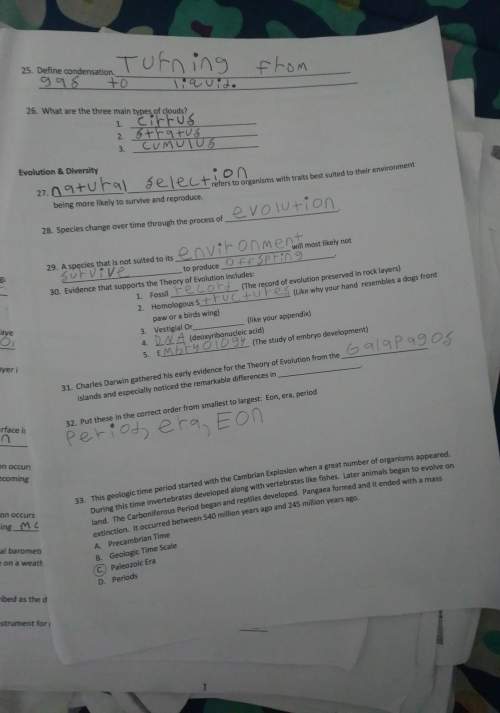
Answers: 3
Another question on Physics

Physics, 21.06.2019 17:10
Aspecial electronic sensor is embedded in the seat of a car that takes riders around a circular loop-the-loop ride at an amusement park. the sensor measures the magnitude of the normal force that the seat exerts on a rider. the loop-the-loop ride is in the vertical plane and its radius is 23 m. sitting on the seat before the ride starts, a rider is level and stationary, and the electronic sensor reads 740 n. at the top of the loop, the rider is upside down and moving, and the sensor reads 370 n. what is the speed of the rider at the top of the loop?
Answers: 1

Physics, 22.06.2019 01:00
Red’s momentum vector before the collision is green’s momentum vector after the collision. question 1 options: shorter than longer than equal to question 2 (1 point) saved since green bounces off red, this must be an collision. question 2 options: explosion inelastic elastic question 3 (1 point) saved red transfers of its momentum to green during the collision. question 3 options: little all most none question 4 (4 points) why does red transfer all its momentum to green? back up your answer with information from the simulation. write at least 2 sentences. question 4 options: skip toolbars for . more insert actions. more text actions. more paragraph style actions. question 5 (1 point) now make red much heavier than green. answer the questions below to describe how both red and green behave after the collision. you might want to play the sim multiple times. click on restart or return balls to start over. to see numbers, check the show values box (inside the green box). red during the collision because it transferred some momentum to green. question 5 options: sped up kept the same velocity slowed down question 6 (1 point) green sped up during the collision as it question 6 options: lost momentum to red maintained a constant momentum. gained momentum from red question 7 (1 point) after the collision . . question 7 options: red bounced off green and went to the left. green moved to the right. both green and red stopped as they have lost all momentum. red stopped and green moved to the right. both green and red moved to the right. question 8 (4 points) only some of red’s momentum was transferred to green. why did this occur? back up your answer with information from the simulation. write at least 2 sentences. question 8 options: skip toolbars for . more insert actions. more text actions. more paragraph style actions. question 9 (1 point) now make red much lighter than green. answer the questions below to describe how both red and green behave after the collision. you might want to play the sim multiple times. click on restart or return balls to start over. to see numbers, check the show values box (inside the green box). which is true about the collision? question 9 options: green slowed down after the collision therefore it must have lost momentum. green sped up after the collision therefore it must have lost momentum. green sped up after the collision therefore it must have gained momentum. green slowed down after the collision therefore it must have gained momentum. question 10 (1 point) since green gained momentum, red had to have momentum because you cannot create or destroy momentum. question 10 options: lost kept the same amount of gained question 11 (1 point) since green was so much and harder to move, it caused red to bounce back to the left giving red . question 11 options: lighter. . . . negative heavier . . . . negative lighter. . . . positive heavier . . . . positive question 12 (4 points) now, click on more data at the bottom of the sim. play with different numbers for the masses and starting velocities. you can even make the starting velocities negative! tell me one thing you discovered by adjusting the speeds and masses. write at least 2 sentences. be specific and use words like velocity, momentum, mass, increased, decreased, etc. question 12 options: skip toolbars for . more insert actions. more text actions. more paragraph style actions. part 2: inelastic collisions question 13 (1 point) click on the "less data" box at the bottom of the sim. in the green box, slide the elasticity meter all the way to inelastic so there is 0% elasticity: make the masses whatever size suits you. make sure that green starts out with a velocity of 0 m/s – if you didn’t change this in the last step, you don’t need to do anything. push play and observe! true or false: when red and green collide, they stick together. question 13 options: true false question 14 (1 point) the velocity of red & green after the collision is the velocity that red started off with. question 14 options: larger than smaller than equal to
Answers: 1

Physics, 22.06.2019 08:00
What is a carrier wave and how does it affect what you hear on the radio
Answers: 1

Physics, 22.06.2019 22:30
The record distance in the sport of throwing cowpats is 81.1 m. this record toss was set by steve urner of the united states in 1981. assuming the initial launch angle was 45° and neglecting air resistance, answer the following. (a) determine the initial speed of the projectile. m/s
Answers: 2
You know the right answer?
PLEASE HELP DUE SOON
...
...
Questions
























